The most popular dish of Spain – Spanish Paella – is made with rice, saffron, vegetables, and meat, usually chicken, sausage, mixed seafood, and sometimes even rabbit. You can make this dish without any special equipment for an authentic taste of Spain at home.
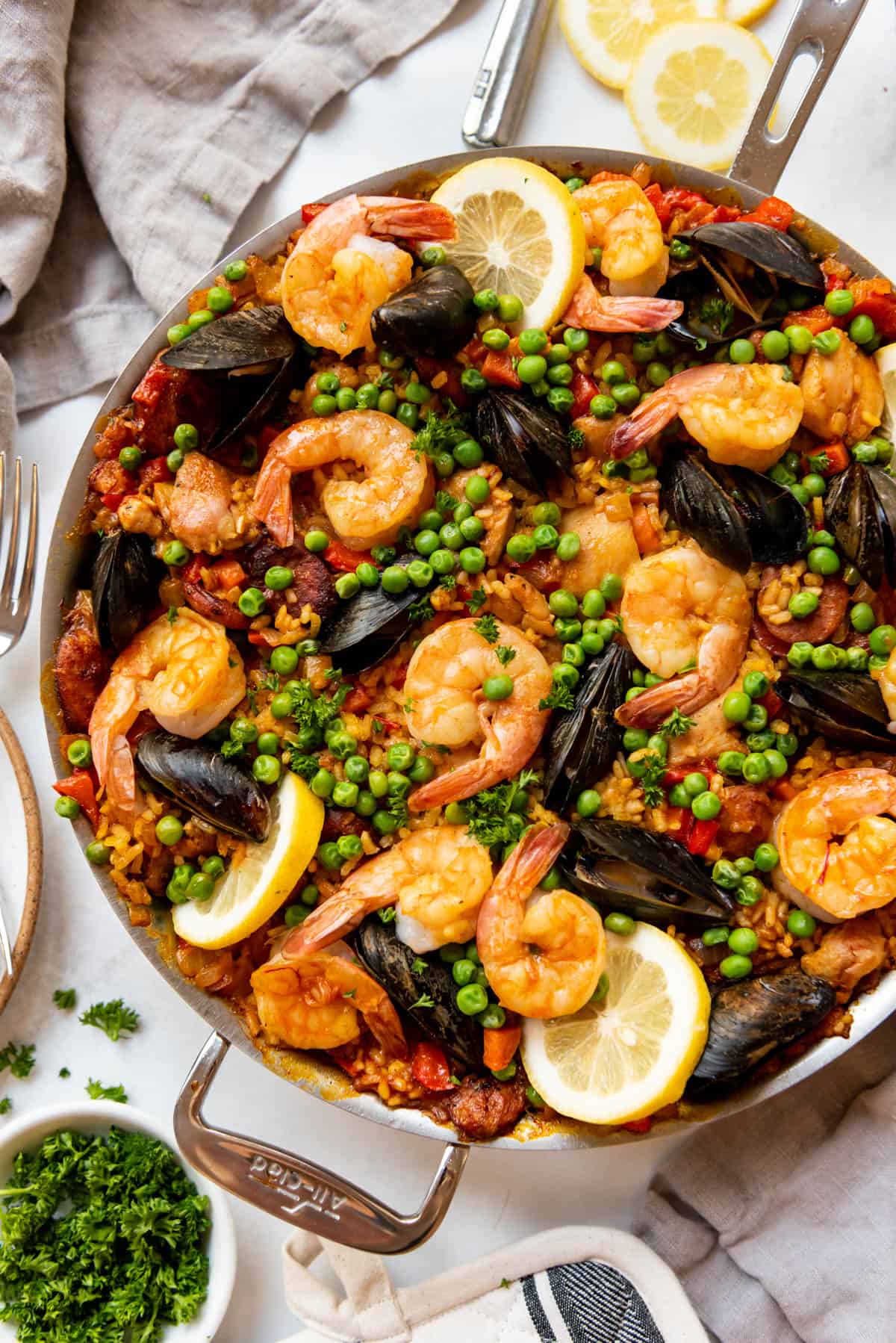
We ate so much authentic paella when Paul and I traveled to Madrid and through Spain that I had to learn how to make it when we got home. It has incredible textures and flavors with and is one I have even taught to friends for a fun group date night.
I recommend serving your paella family style right in the pan you cooked it in for everyone to scoop up as much as they would like so they can get some of the crispy rice crust (called “socarrat”) on the bottom!
What is Paella?
Paella is an authentic Spanish dish that originated in the Valencia region of Spain. It is typically made with short-grain bomba rice, saffron threads for color and aroma, a variety of vegetables, and some type of meat or seafood.
Traditional Spanish paella is cooked over an open flame in a wide, shallow pan called a “paellera.” The ingredients are added in layers and cooked slowly, allowing the flavors to meld together.
Paella is a staple dish in Spanish cuisine and is served in a large paella pan at family gatherings and special occasions.
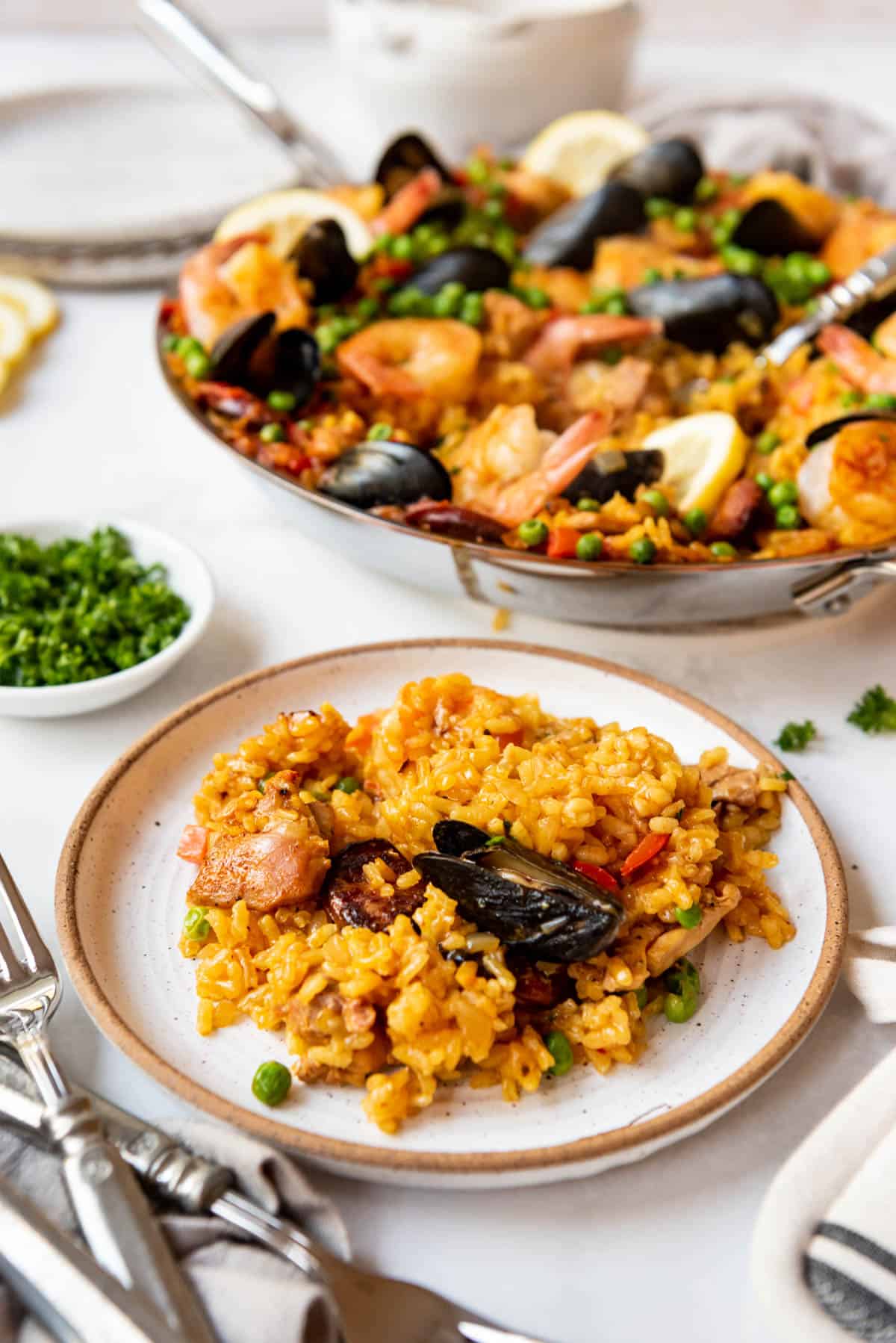
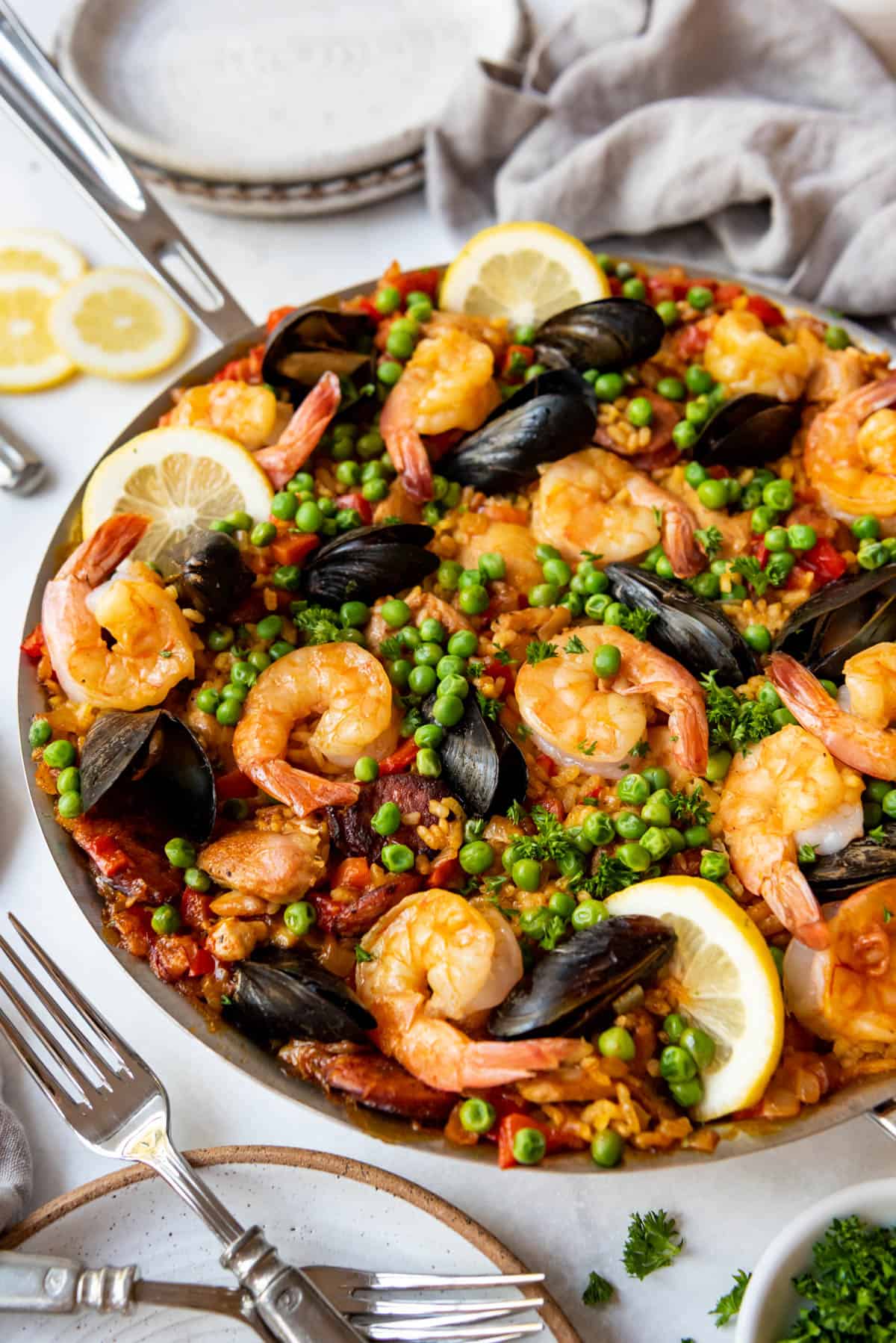
Recipe Ingredients
Paella ingredients are simple although the list might look long. Keep scrolling to the printable recipe card below for full amounts.
- Bomba rice – This is a particular kind of Spanish rice that is key for making really great traditional paella. Calasparra rice, another short grain rice, can also be used.
- Chicken broth – The recipe is written with just the right amount so the rice cooks through without having too much liquid, which could prevent the socarrat from forming on the bottom of the pan.
- Chicken – We prefer using chicken thighs because they are more moist and less likely to overcook.
- Olive oil
- Meat – Along with chicken, I like using chorizo sausage, prawns or jumbo shrimp, and mussels.
- Vegetables – Onion, bell pepper, carrot, garlic, and frozen peas are all common. Green beans and fava beans are also popular options.
- Tomato paste – Adds depth of flavor and richness.
- Smoked paprika – We prefer the smokey, robust flavor of smoked paprika since traditional paella is cooked over an open fire, but you can sub sweet paprika if that’s what you have on hand.
- Saffron threads – The orange-red threads give the paella its signature color and a wonderful aromatic quality.
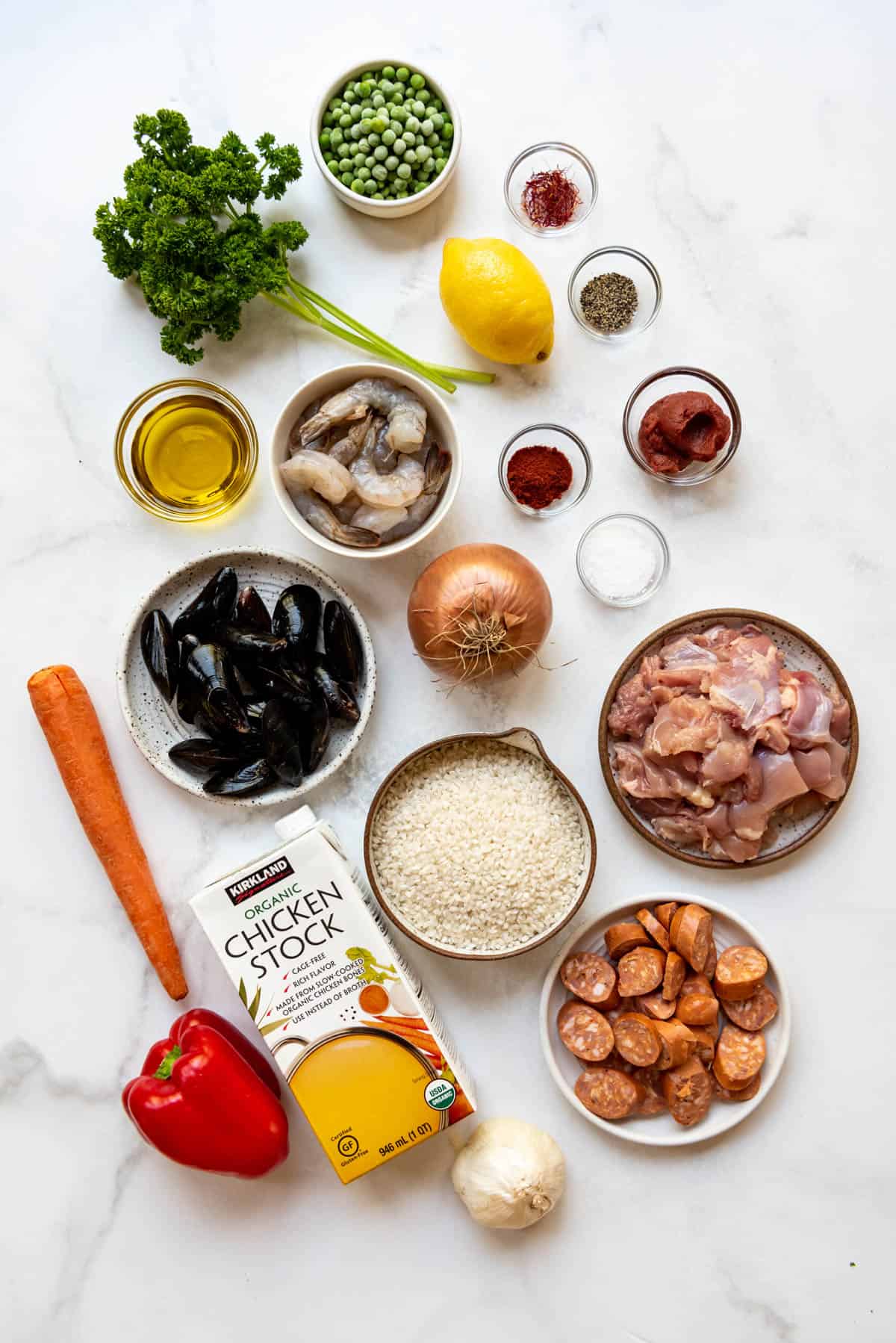
How to Make Paella
- Sear the chorizo. Heat the oil in a large skillet over medium heat to medium-high heat. Brown the chorizo on both sides for 2-3 minutes per side. Remove with a slotted spoon and set aside. If you aren’t using chorizo sausage, just skip this step, but we like to do it first to flavor the oil before cooking the vegetables in it.
- Saute the veggies. Add onion, carrot, bell pepper, and garlic and saute for 5-7 minutes until the onion is translucent.
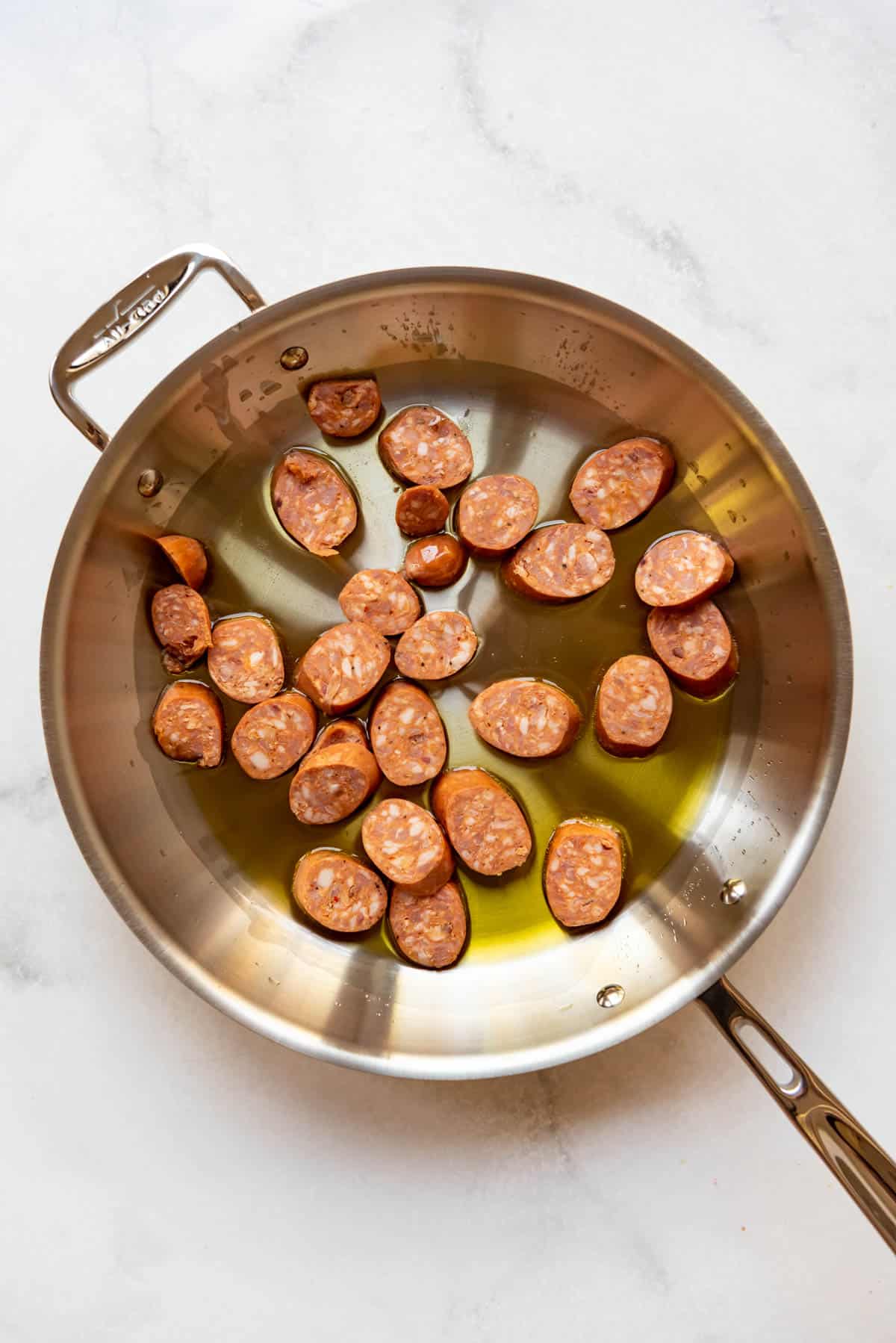

- Add seasonings. Add tomato paste and stir for 1 minute. Then add the paprika, saffron, and season with 1 teaspoon salt & ¼ teaspoon pepper. Continue to cook and stir for 3-5 minutes to really let all of the flavors develop.
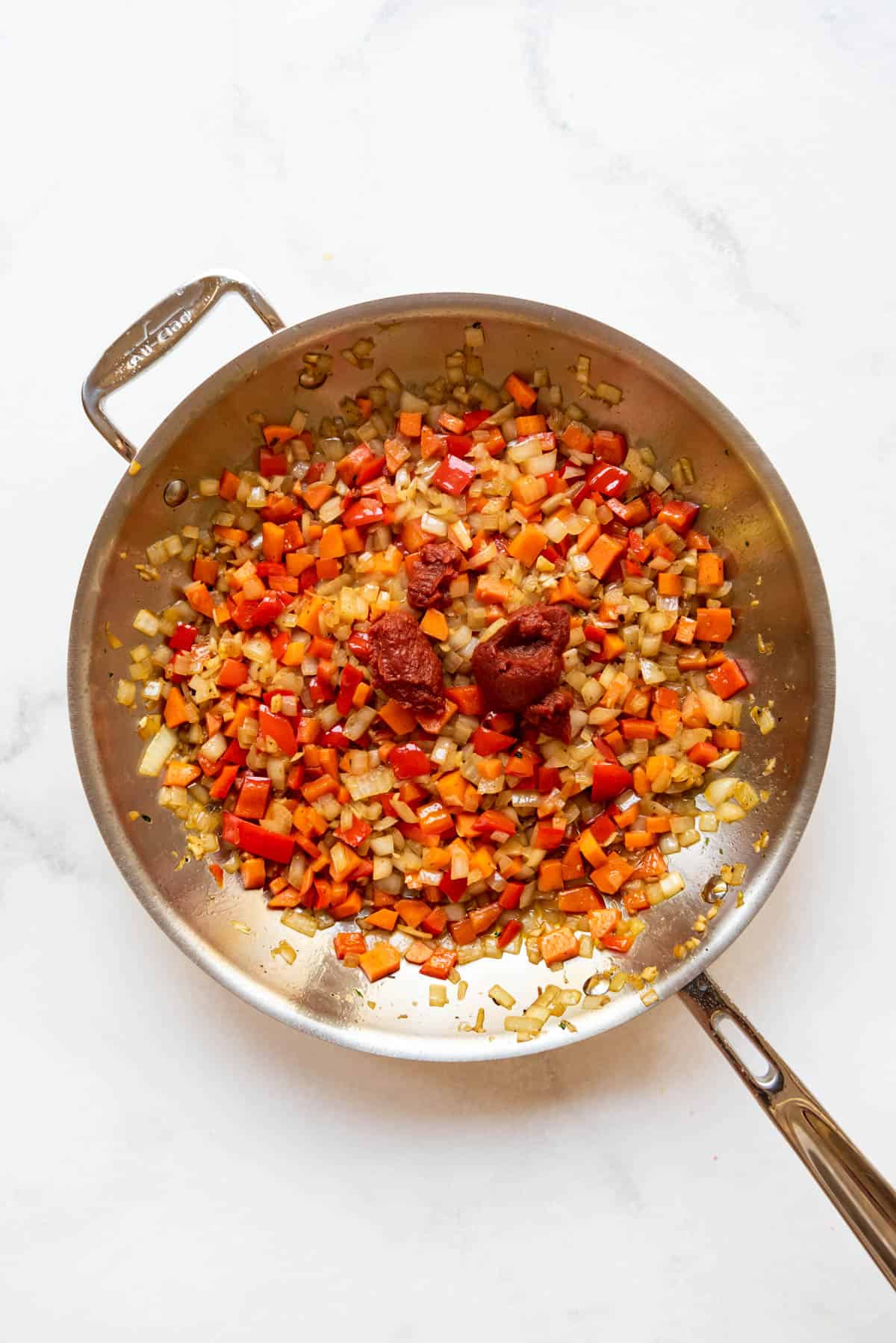
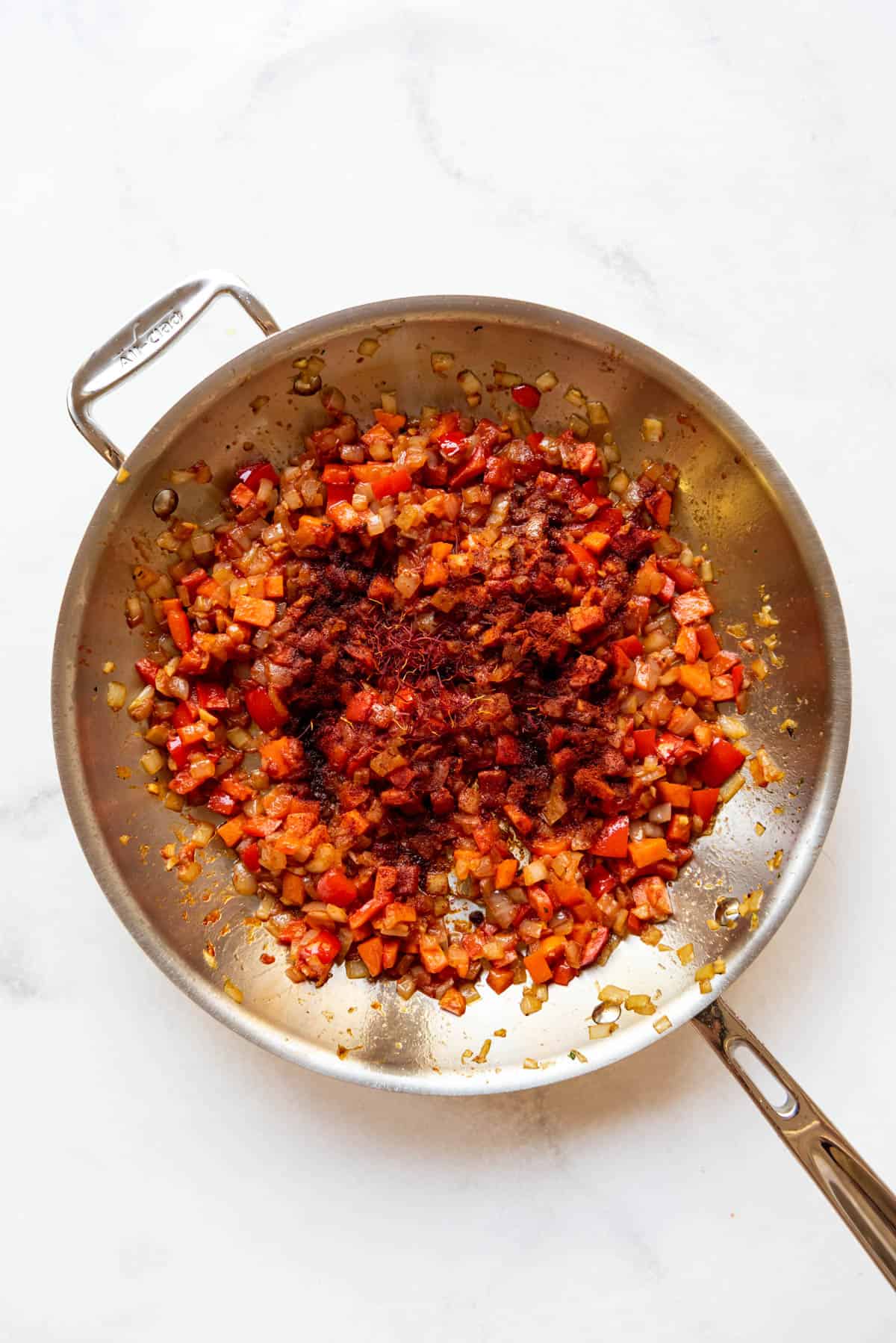
- Add chicken. Season chicken thigh pieces with the remaining 1 teaspoon kosher salt and ¼ teaspoon pepper. Add the chicken to the pan with the vegetables and oil. Return the chorizo to the pan. Cook and stir for 1 minute. We’re not trying to cook the chicken through at this point – just get a little color on it and get it incorporated with all the other ingredients before adding the rice and the liquid.
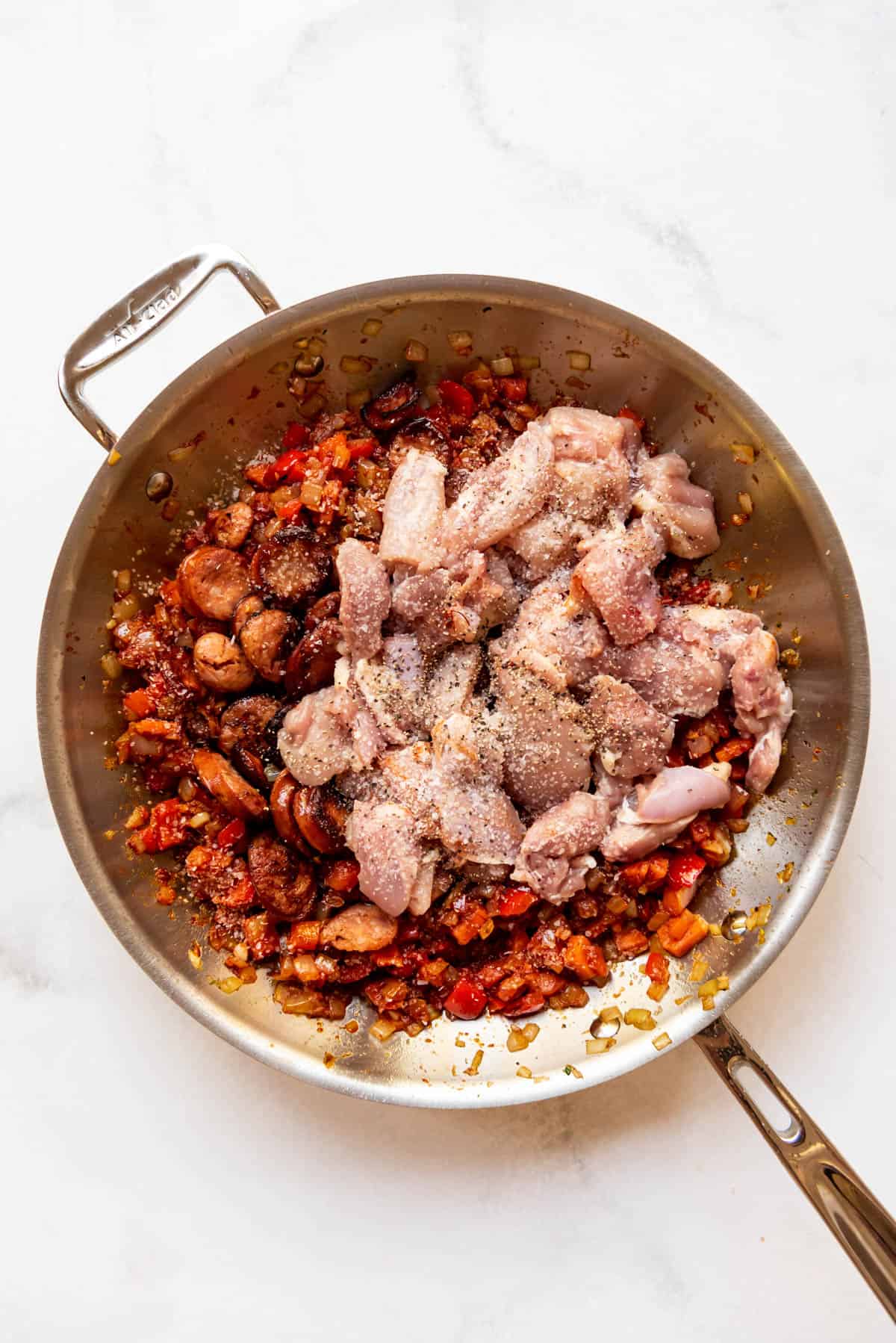
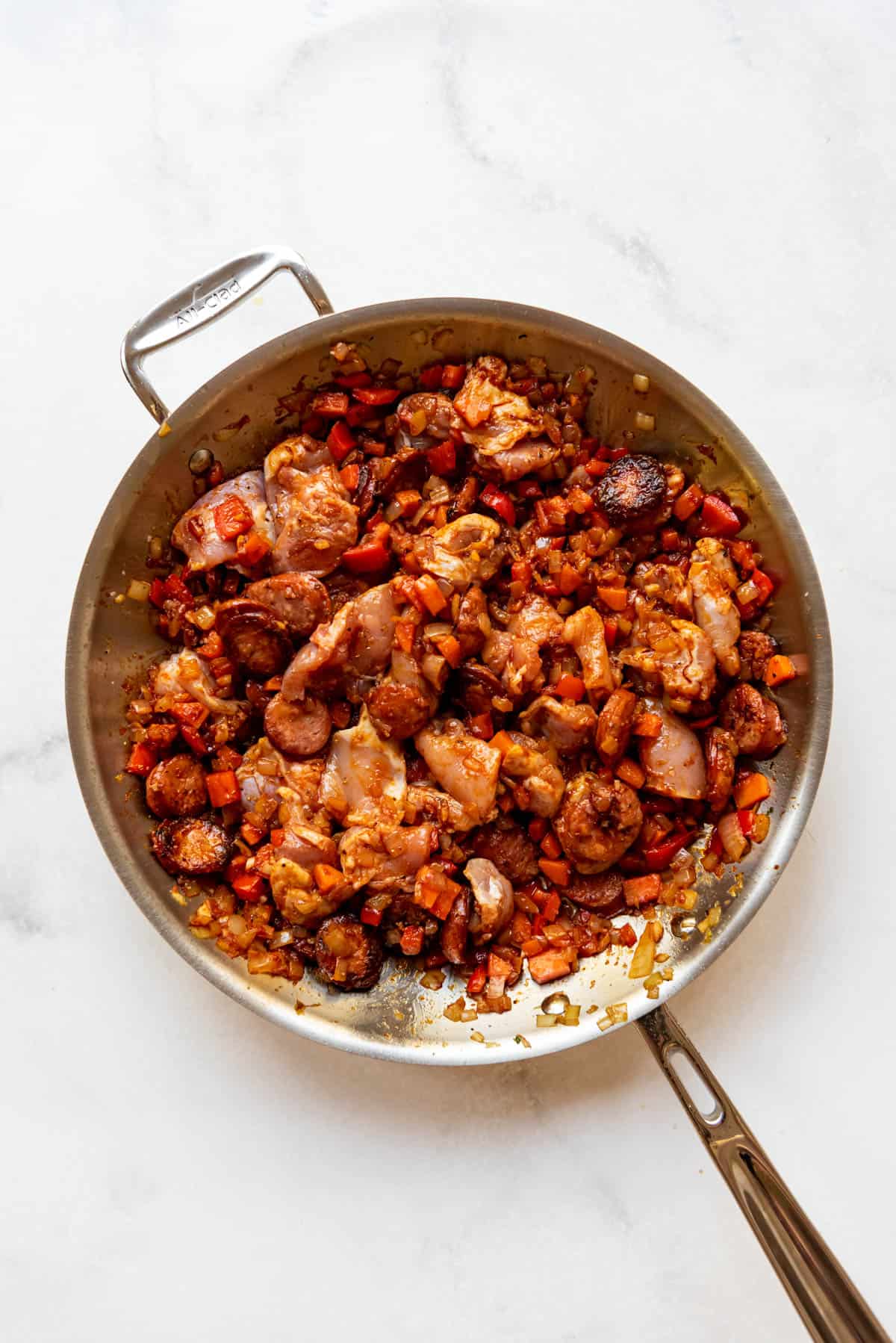
- Stir in paella rice. Add the paella rice to the pan with the veggies and meat. Stir everything together so the individual rice grains are coated in the seasonings and oil from the pan.
- Add liquid. Slowly pour the broth or chicken stock around the pan (it fills my large 12×2-inch pan almost complete full to the brim). Give the pan a shake to settle the rice grains into the liquid so they cook but do not stir from this point onwards. You want a crusty layer of rice to form on the bottom of the pan. Stirring not only prevents the crust from forming but it also results in mushy rice, which is not what you want in this dish.

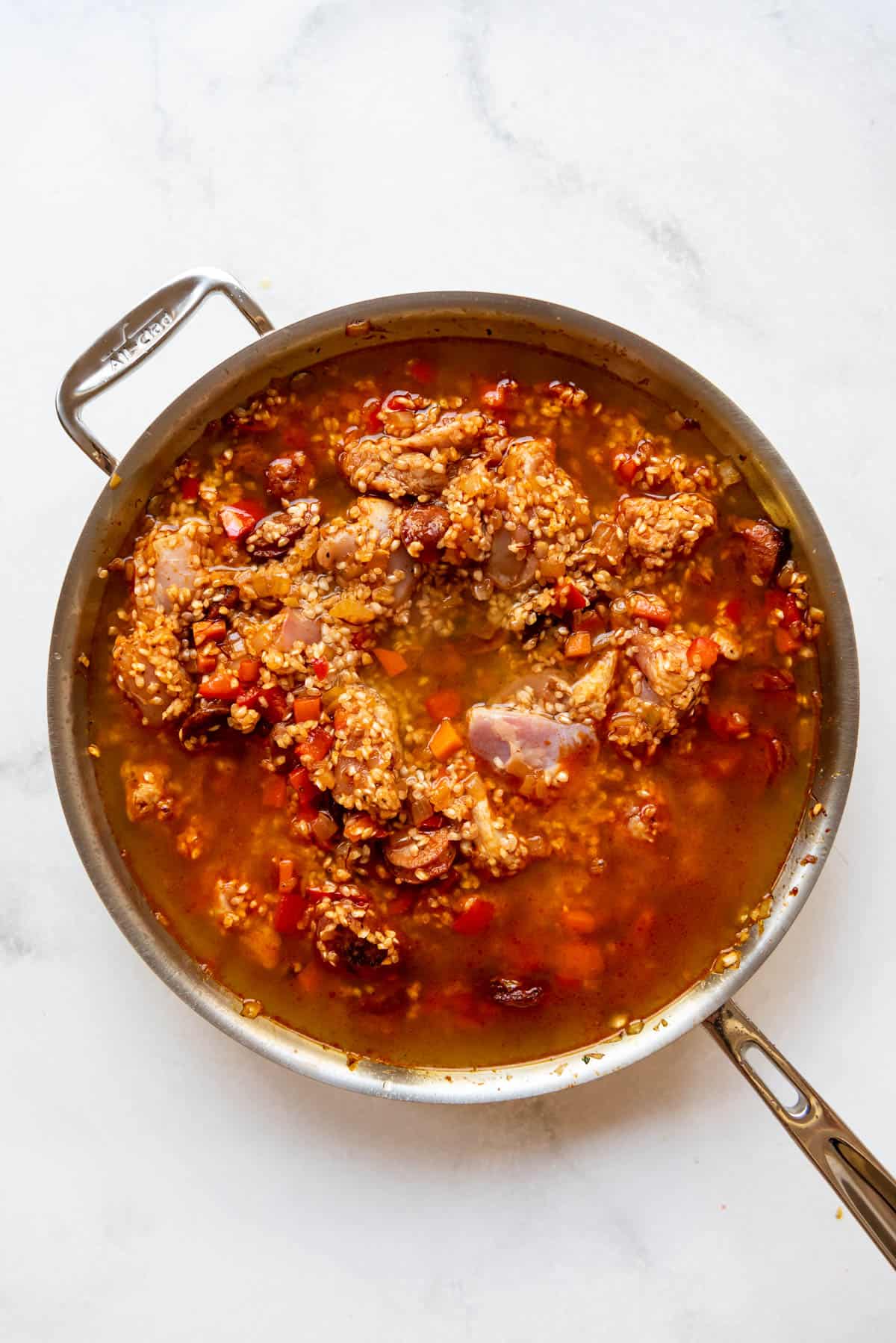
- Cook. Bring the liquid in the pan to a boil, then reduce heat to medium-low. Cook for 15-18 minutes uncovered, shaking the pan once or twice during the cooking process.
- Add seafood, if using. Add any seafood like shrimp, prawns, mussels, clams, or calamari at this point, if using, and sprinkle the peas on top. You can nestle the seafood down into the rice a bit. Continue to cook uncovered for 5 more minutes until done. The liquid should be mostly absorbed and the rice should be tender.
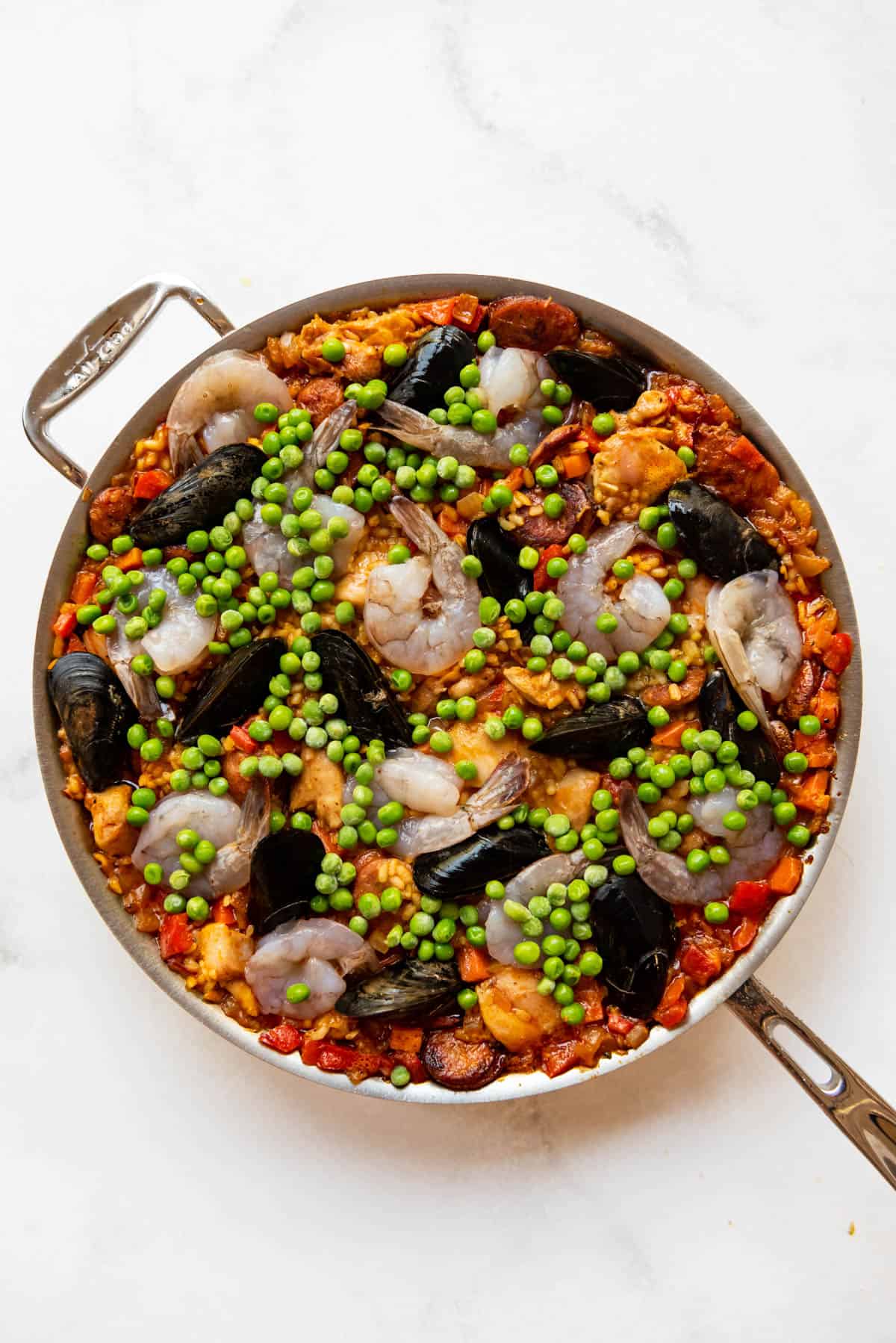

- Let rest. Once the paella is done, remove it from the heat and let it rest, covered, for 10 minutes before serving. Sprinkle with fresh parsley and serve with lemon slices.
Some of the most common types of paella are:
- Valencian paella – The original version of paella from the region of Valencia in Spain where it is known as “paella Valenciana”. It is made with chicken, rabbit, snails, green beans, and white beans.
- Seafood paella – As the name suggests, this version of paella is made with a variety of seafood such as shrimp, mussels, and clams.
- Mixed paella – This version combines both meat and seafood, usually chicken, rabbit, and a variety of seafood.
- Chorizo paella – Another common ingredient in many paella recipes is a spicy Spanish sausage known as chorizo. It’s different from Mexican chorizo, so if you have a hard time finding it, andouille sausage is a decent substitute and much easier to find in most grocery stores.
- Vegetarian paella – This version of paella is made with vegetables such as bell peppers, tomatoes, onions, and artichokes.
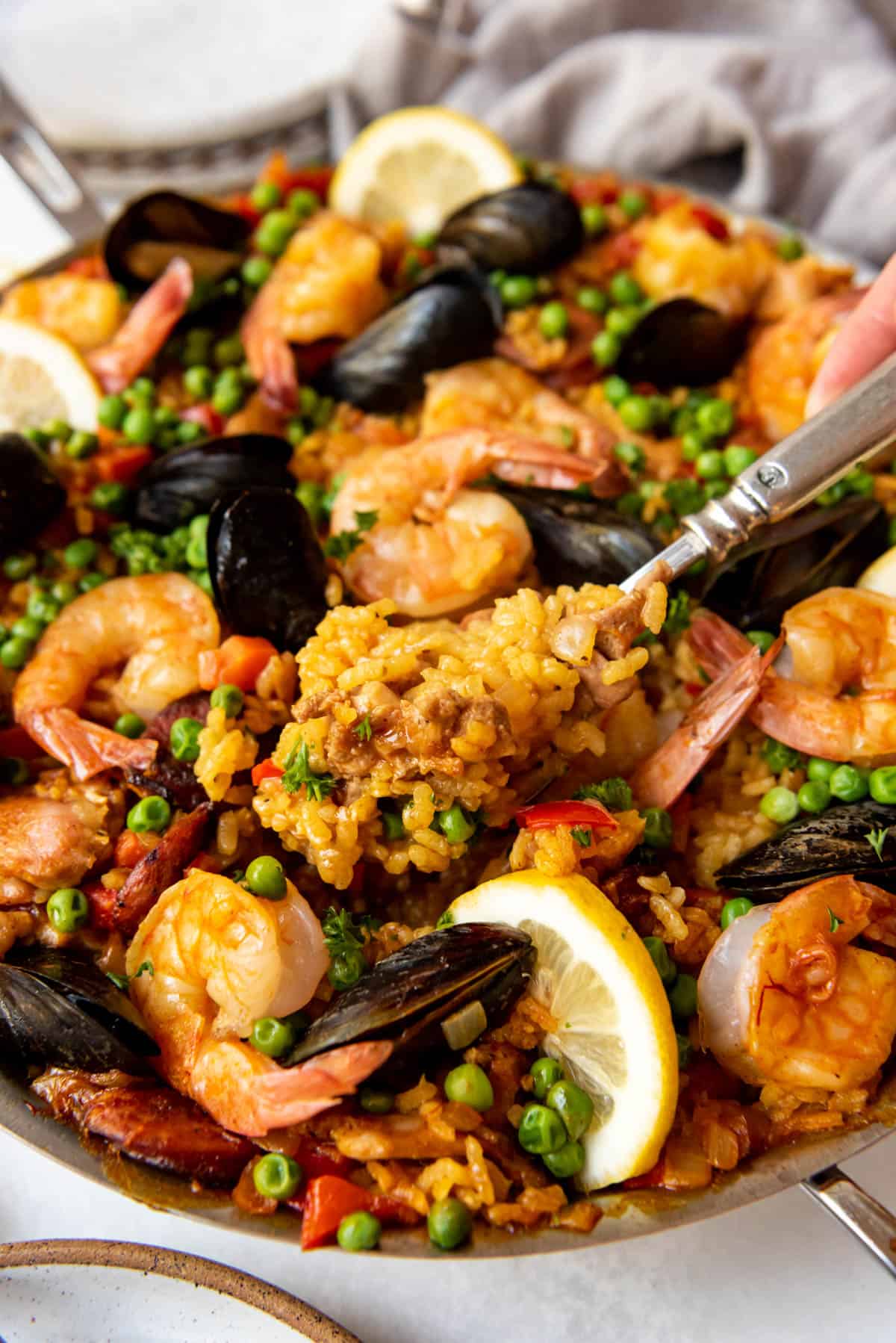
Recipe FAQ’s
The crust that forms on the bottom of the paella pan is known as “socarrat” and it is absolutely delicious! The caramelized golden brown rice layer that many people consider the best part of paella is usually formed by increasing the heat right at the end of cooking to form the crispy crusty bottom layer of rice that is the mark of really excellent paella.
The type of rice you use for paella is crucial to achieving the perfect texture and flavor. The traditional rice used in paella is a short-grain variety known as Bomba rice or sometimes just “Spanish rice” or “paella rice”. You can find it online at Amazon or at Whole Foods, World Market, or at a well-stocked supermarket.
In general, it’s best to use short-grain rice with a high starch content for paella, as this type of rice can absorb the liquid and flavors of the other ingredients without breaking apart or becoming sticky or mushy. In a pinch, you can use Calrose rice, which is another short-grain rice, but you should decrease the chicken broth to 4 cups since it doesn’t absorb as much liquid as bomba rice.
No, you do not need a special paella pan to make this paella recipe. Choose a shallow, wide pan like a 12-inch skillet so there is plenty of surface area to help form the crusty rice layer at the bottom of the paella.
I don’t recommend using a cast iron pan for paella. Cast iron retains heat and I have found it hard to cook paella properly in cast iron versus my all-clad regular pan because of the heat regulation that happens when cooking paella.
Tips and Suggestions
- Use a big enough skillet. You can buy specially made paella pans, which are wide and shallow for more surface area for the crispy rice crust on the bottom, but my largest 12″ all-clad skillet works great.
- Do not wash the rice. This removes the outer layer of starch, which we want in this dish.
- Try making this on the grill! Traditional paella is cooked over an open fire, so if you have a pan that you can use on the grill I say go for it!
- Don’t add the seafood too soon. Seafood cooks quickly and becomes rubbery and tough if overdone so wait until close to the end before adding it. Once the shrimp have turned pink and are cooked through they are done.
Storage & Reheating Instructions
Leftover paella is absolutely delicious the next day. It will keep for 2-3 days in an airtight container in the fridge or you can freeze leftovers for up to 2 months.
To reheat, you can cover it with foil and stick the paella in a 375°F oven for 10-15 minutes or microwave individual portions. You will lose some of the crustiness of the bottom layer of rice with this approach, but it’s still going to be pretty darn delicious paella.

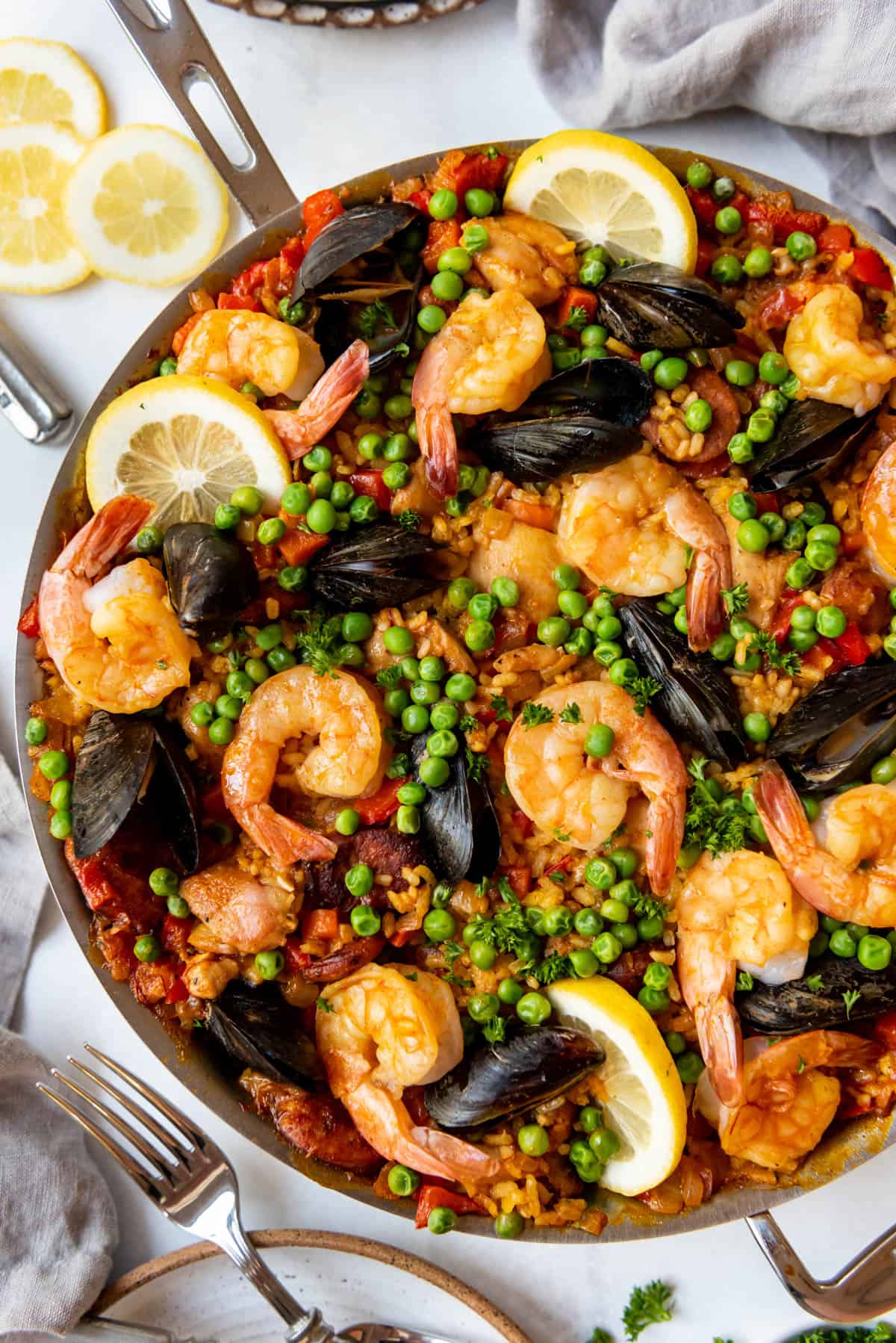
More Rice Dishes
Spanish Paella Recipe (Seafood, Chicken, and Chorizo)
Ingredients
- 1/4 cup olive oil
- 1 Spanish chorizo, cut into 1/2-inch discs (Andouille sausage is a good substitute)
- 4 boneless, skinless chicken thighs, cut into 1-inch pieces
- 2 teaspoons kosher salt, divided
- 1/2 teaspoon freshly ground black pepper, divided
- 1 large onion, diced
- 1 large carrot, peeled and diced
- 1 red bell pepper, diced
- 4 cloves garlic, minced
- 2 Tablespoons tomato paste
- 1 teaspoon smoked paprika
- 1 teaspoon saffron threads (about 2 pinches)
- 1/4 cup chopped fresh parsley, divided (or carrot tops or chives)
- 2 cups Bomba rice or Calasparra rice
- 5 cups chicken broth or vegetable stock
- 8-12 ounces prawns or jumbo shrimp, peeled and deveined, tails on
- 8-12 ounce cleaned mussels, beards removed (optional)
- 1/2 cup frozen peas
- Lemon wedges, for serving
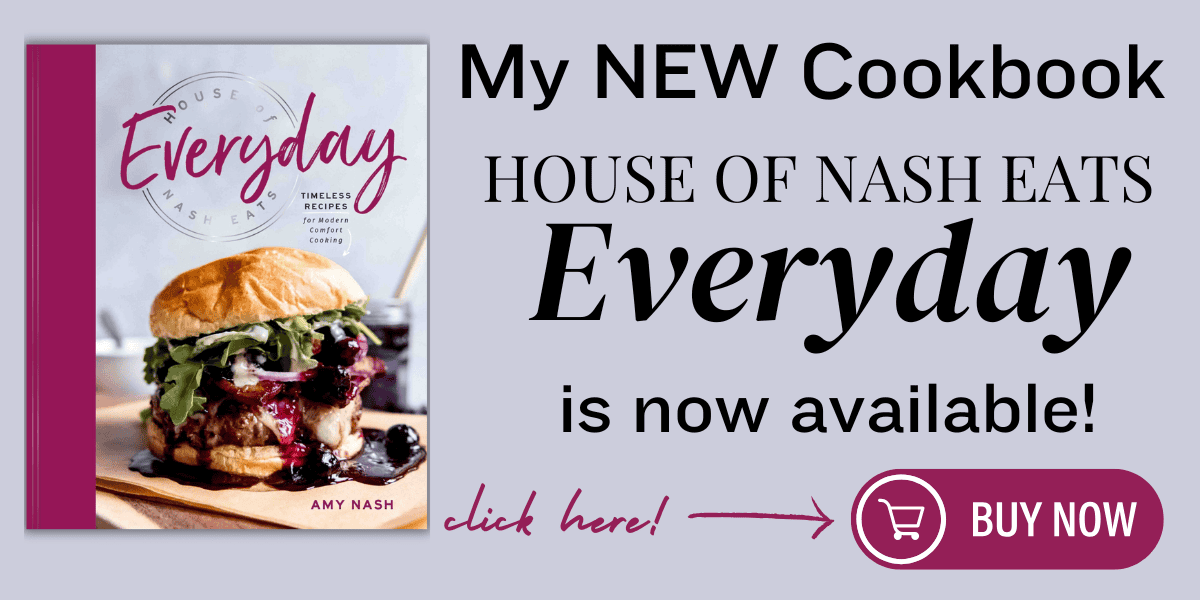
Instructions
- Heat the oil in a large skillet over medium to medium-high heat. Brown the chorizo on both sides for 2-3 minutes per side. Remove with a slotted spoon and set aside.¼ cup olive oil, 1 Spanish chorizo,
- Add onion, carrot, bell pepper, and garlic and saute for 5-7 minutes until the onion is translucent.1 large onion,, 1 large carrot,, 1 red bell pepper,, 4 cloves garlic,
- Add tomato paste and stir well, cooking for 1 minute. Add paprika, saffron, half of the fresh parsley, and season with 1 teaspoon salt & ¼ teaspoon pepper. Continue to cook and stir for 5 minutes.2 teaspoons kosher salt,, ½ teaspoon freshly ground black pepper,, 2 Tablespoons tomato paste, 1 teaspoon smoked paprika, 1 teaspoon saffron threads, ¼ cup chopped fresh parsley,
- Season chicken thigh pieces with remaining 1 teaspoon kosher salt and ¼ teaspoon pepper. Add chicken to the pan with the vegetables and oil. Return the chorizo to the pan. Cook and stir for 1 minute. The chicken will not be cooked through and that's okay.4 boneless, skinless chicken thighs,
- Add rice to the meat and veggies. Stir well to coat each of the rice grains in seasonings and oil from the pan.2 cups Bomba rice
- Slowly pour the broth around the pan. Give the pan a shake to settle the rice grains but do not stir from this point onwards. You want a crusty layer of rice to form on the bottom of the pan. This is called the socarrat and it is key to a really good paella. Stirring not only prevents the crust from forming but it also results in mushy rice, which is not what you want in this dish.5 cups chicken broth
- Bring to a boil, then reduce heat to medium-low. Cook uncovered for 15-18 minutes, giving the pan a shake once or twice during the cooking process, but do not stir. If it sounds like the paella is drying out before the rice has cooked through, you can add a splash of extra liquid or reduce the heat a little more.
- Add any seafood like shrimp, mussels, clams, or calamari at this point, if using, and sprinkle the peas on top. You can nestle the seafood down into the rice a bit. Whether you are adding seafood or not, continue to cook the paella uncovered for 5 more minutes until done (about 20 to 23 minutes total time after adding the liquid to the rice). The liquid should be mostly absorbed and the rice should be tender.8-12 ounces prawns or jumbo shrimp,, 8-12 ounce cleaned mussels,, ½ cup frozen peas
- Remove the paella from the heat and let it rest for 10 minutes. Sprinkle with fresh parsley and serve with lemon slices.Lemon wedges,
Notes
- Rice: You can substitute a medium-grain rice like Calrose rice, if necessary, although Spanish rice like Bombo or Calasparra is more authentic. Do not rinse the rice before cooking.
- Protein: Other popular options other than the seafood, chicken, and chorizo listed above include pork or ham, turkey, rabbit, or a combination of any of the above.
- Storage: Leftover paella is absolutely delicious and we always fight over who gets it for lunch the next day. It will keep for 2-3 days in an airtight container in the fridge or you can freeze leftovers for up to 2 months.
- Reheating: To reheat, you can cover it with foil and stick the paella in a 375°F oven for 10-15 minutes or microwave individual portions. You will lose some of the crustiness of the bottom layer of rice with this approach, but it’s still going to be pretty darn delicious paella.

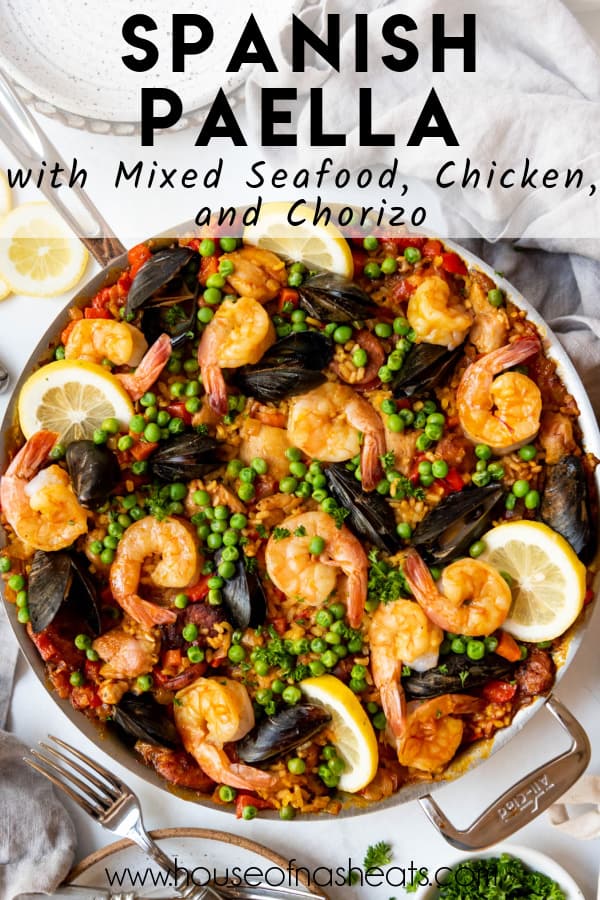
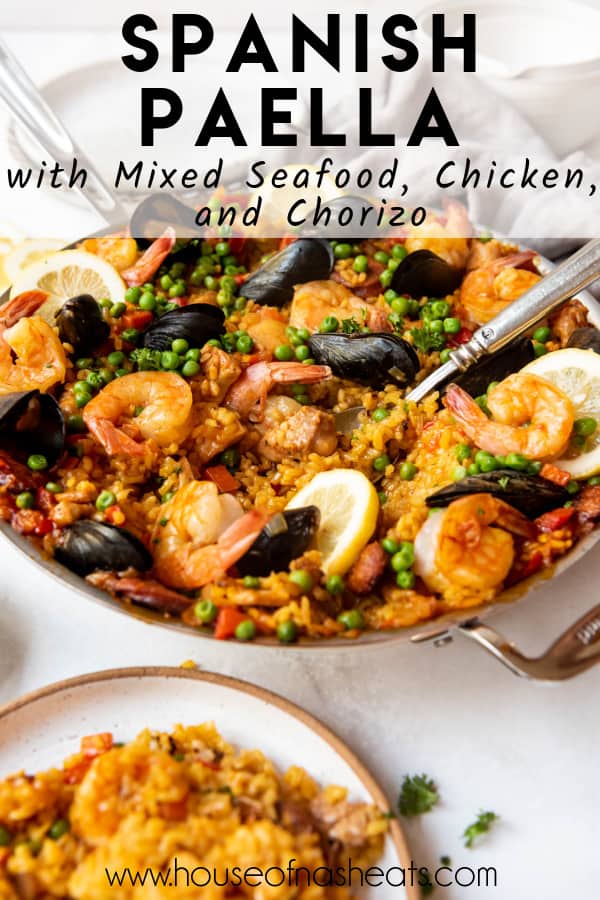
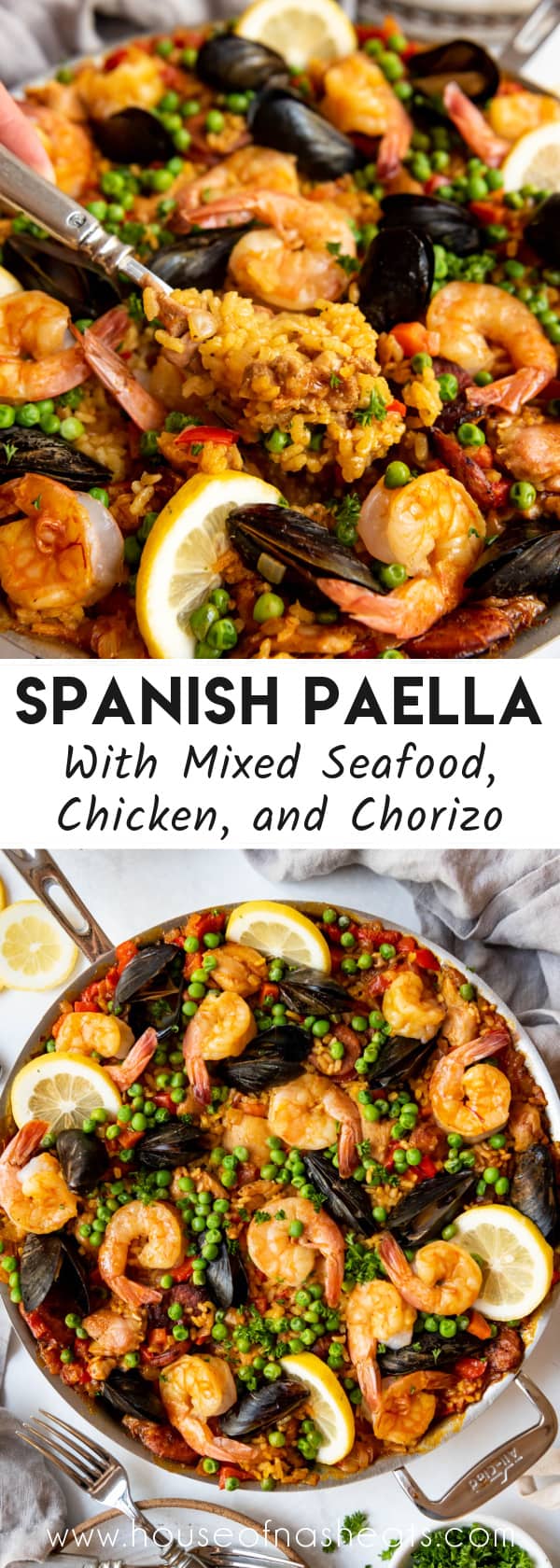
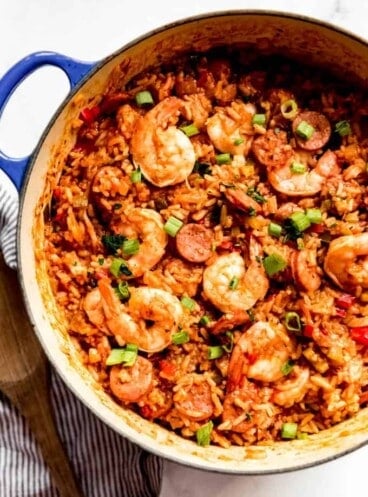
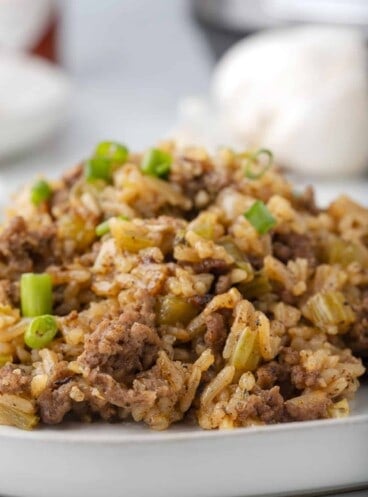
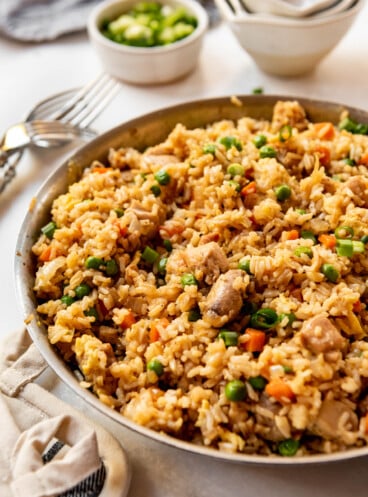
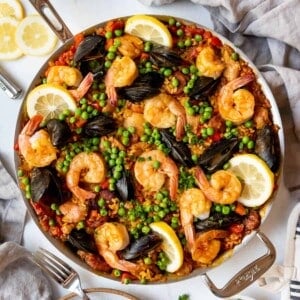
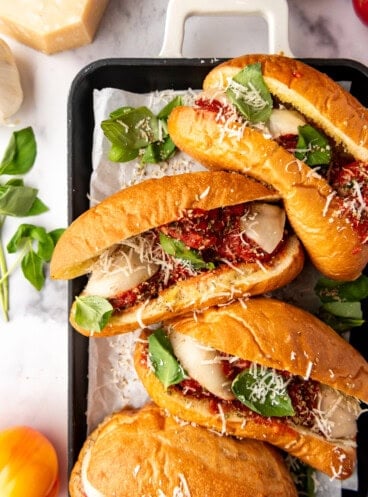
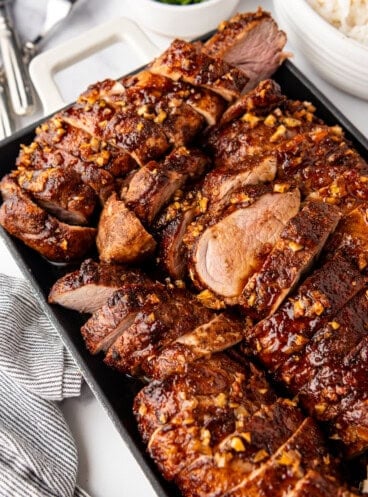



Dear Amy,
I enjoyed your post and how you include the different paellas that we make.
I must let you know that we never ever ever put chorizo in paella. Never. A lot of non-spanish people eat paella with chorizo because Jamie Oliver made such a recipe, and now you can only find paella with Chorizo in the UK. We hate him in Spain and we would ban him entry if we could. Please do not spread more paella with chorizo recipe. We are quite proud of our recipes, food is very important in our culture and we truly hate when our recipes are modified in such viles ways.
best of wishes 🙂
Wow, I had no idea but thank you so much for telling me!
I made this outdoors in a paella pan on a Weber grill. The direction to cook the rice uncovered led to disaster. I could not get the rice on top to turn tender, and by the time I gave up, the rice at the bottom of the pan was mushy. I later checked the paella rice directions on the package which said to cook it covered.
#3 states add chicken and rice. I did not add rice until Step #4 which also says add rice. The dish was wonderful. I also added some sun dried tomatoes. I used andouilli.a great substitute. Thank you!
Thank you for pointing that out! Yes, adding it in step 4 is correct. I’ve fixed the mistake in the recipe card.
I made this tonight for my husband and mother in law. It was so amazing! The only thing I did different was add a couple of tomatoes I needs to use up. Perfection.
I loved this recipe. Did a test run for a dinner party I am having for 14 people Friday night. Hubby thought the rice wasn’t cooked and too crunchy. I explained the rice and he still was not sold. But, when I make the original recipe Friday x 2, it will be better for him. Thank you.
Hello. I’m going to make this Paella for 18 people. Can I use Arborio rice and also use white wine in addition to the chicken stock? Thank you
I would stick to Bomba rice if you can. You can also look for Calasparra rice, which is another short grain rice that can be used for this easy paella recipe. I don’t recommend using regular white rice or even arborio rice, which is used for risotto.
You could probably do a combo of white wine and chicken stock but I wouldn’t add any more liquid because it will be too much for the rice to absorb.
Mixed paella shold be considered illegal plus adding chorizo to food does not make it more spanish
Yum! This recipe is very tasty! I use Zatarain’s Andouille Sausage, though, instead of Spanish chorizo.
Sounds great! Glad you like it!
I found this to be a tasty easy recipe and my husband loved it. My only deduction is because the time was off on the seafood. My raw shrimp needed to cook for 10-15 minutes instead of 5 as the recipe states. I did use a 20 oz defrosted bag of frozen seafood mix that I found at my local grocery store.
Yes sometimes cooking times may be different depending on the size of the shrimp, the temperature of the shrimp, or the heat of the pan. Next time I make this I will double check the timing and see if I need to adjust it. I am glad you enjoyed it!
Just to culturalize you british, and with no aim to offend. First of all is not spanish paella, is valencian paella, that is a distinguished region from spain. For you to understand is like calling Scotish Haggis English’s. Also, AÇÒ NO ÉS PAELLA ÉS ARRÓS AMB COSSES. For a real Paella Valenciana, search in google that, ”paella valenciana” that indeed is easyer to make, it has no fish, and mostly NO LEMON. If you want the seafood one, look up for ”Arrós del senyoret” that has squid, mussels bu WITHOUT THE SHELL and the shrimps.
Hope it helps to upgrade foriner’s cook skills👍🏼
This was my first attempt at making paella and it was delicious! I had to substitute s couple things due to last minute availability of ingredients.
I used brats instead of chorizo
I used chipotle seasoning instead of paprika ( thought i had paprika and come time to cook discovered that i didn’t have it.)
Spice level was moderate and the dish turned out perfect!
Great Nicole! And yes that happens to me all the time, substituting ingredients! Sounds like it turned out delicious!